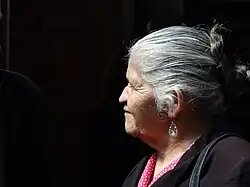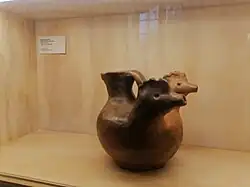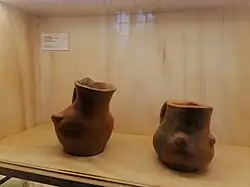Dominga Neculmán
Dominga Neculmán | |
|---|---|
 Dominga Neculmán in 2011 | |
| Born | 1937 Padre Las Casas, Araucania, Chile |
| Died | 5 December 2022 Padre Las Casas, Araucania, Chile |
| Nationality | Mapuche, Chilean |
| Style | wizüfe |
| Movement | Indigenous ceramics of the Americas |
| Awards | Lorenzo Berg Award (1986)[1], Living Human Treasure (Chile, 2011)[2], Illustrious Daughter of Padre Las Casas (2022)[3] |
Dominga Neculmán Mariqueo (1937 – 5 December 2022) was a Mapuche Chilean ceramist, who was declared Chile's Living Human Treasure in 2011 for her mastery and promotion of the traditional Mapuche pottery technique, wizüfe.
Early life
Neculmán was born in 1937 in the Mapuche community of Juan Mariqueo, in the rural village of Roble Huacho, Padre Las Casas, Chile. She grew up with her mother and grandmother, both of whom were potters. Neculmán wanted to learn the craft from an early age, but her mother refused because of the hard work involved, so she learned the witral weaving technique with sheep wool instead.[1][4]
Artistic career

After his mother passed away at the age of 33, Neculmán began practising pottery thanks to what she had observed at home and by learning from other master potters of the region. Neculmán soon became well known and attracted the attention of researchers and academics who saw her as having a special technique.[4]
Neuclmán's technique was characterised by the almost exclusive use of her hands and materials such as clay (or üku) and loam (or raq).[4]
Awards and honors

In 1986, the Catholic University of Chile gave Neculmán the Lorenzo Berg Award for Best National Craftswoman.[1]
The Chilean Ministry of Culture named her a Living Human Treasure in 2011 for her extensive knowledge of the art of pottery.[2]
In March 2022, she was officially declared an illustrious daughter of Padre Las Casas alongside epewtufe (storyteller) Paula Painén.[3]
Language advocacy
Neculmán also taught mapudungún language in the Intercultural Bilingual Education programme at the Temuco Catholic University and participated in the Mapuche Ceramics course at the Catholic University of Chile.[5]
Death and legacy
Neculmán died on 5 December 2022 and was one of the last masters of the Mapuche pottery technique.[6]
References
- ^ a b c "Catálogo Patrimonial. Epu Alka Metawe". Pontifical Catholic University of Chile.
- ^ a b Pesar por fallecimiento de la alfarera y Tesoro Humano Vivo Dominga Neculmán (in Spanish)
- ^ a b "Paula Painén y Dominga Neculmán son declaradas "Hijas Ilustres de Padre Las Casas"". Municipality of Padre Las Casas.
- ^ a b c "Pesar por fallecimiento de la alfarera y Tesoro Humano Vivo Dominga Neculmán". Ministry of Cultures, Arts and Heritage. 6 December 2022.
- ^ Gómez, María José (7 December 2022). "Quién fue Dominga Neculman, la alfarera mapuche reconocida como "Tesoro Humano Vivo" por la Unesco". La Tercera.
- ^ Cabrera, Manuel (5 December 2022). "Muere Dominga Neculmán, Tesoro Humano Vivo y una de las últimas expositoras de la alfarería mapuche". Radio Bío-Bío. Archived from the original on 29 January 2023. Retrieved 6 August 2025.
External links
- Dominga Neculmán Mariqueo, video (Spanish)